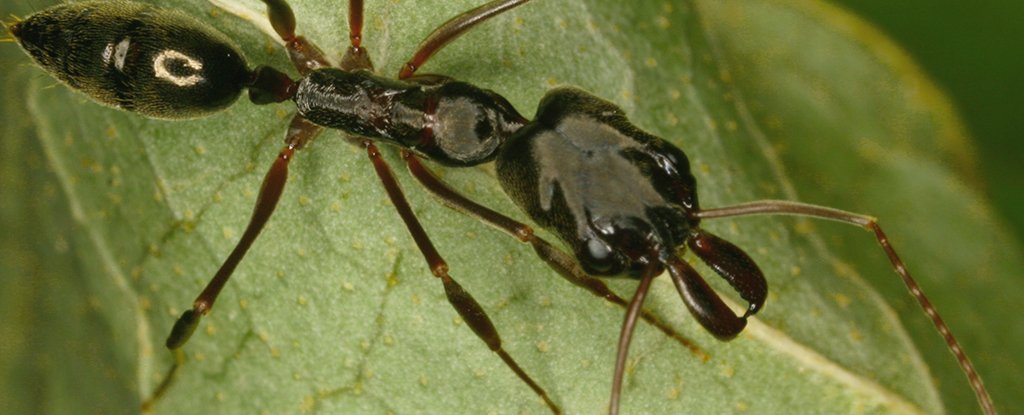Products You May Like
When you’re barely the size of an eyelash and on the hunt for fast-moving prey, having a bear trap strapped to your head might seem like a good idea.
Of course, it’s all fun and games until it actually goes off. Even the slightest wobble in that trap’s arc could send your face on a one-way trip into your back pocket.
Fortunately, the trap-jaw ant has a solution to this problem, safely earning it a place among the quickest snaps in the animal kingdom.
A study by a team of US researchers carried out mathematical modeling on the head anatomy of the trap-jaw ant species Odontomachus brunneus to determine how its mechanical jaws of death deal with the insane forces driving them shut.
Biologists know the ant’s mandibles are relatively simple spring-powered levers, each locked in place by a latch that’s primed to release the moment prey tickles a literal hair-trigger mustache.
Latch-mediated spring actuation (LaMSA) isn’t uncommon among itty-bitty creepy crawlies. As biology shrinks, elastic energy scales far more efficiently than complex biochemical motors, putting a spring in the step (and bite) of all kinds of insects.
There is too much of a good thing, however: The forces even a tiny LaMSA can muster can risk overpowering the materials holding it all together.
Take the Dracula ant (Mystrium camillae) for example. Capable of swinging its mouth parts shut at speeds of around 320 kilometers (198 miles) per hour, it’s officially the fastest moving body part in all of nature.
O. brunneus isn’t quite as fast, but it does deserve a silver medal for an equally impressive 196 kilometers per hour. To achieve this, it rotates each mandible at an equivalent of 470,000 rpm, slicing through the air at the slightest touch to grab its prey in a matter of microseconds.
Amazingly, those same jaws are also capable of the most gentle of manipulation, carrying young and other materials around with great dexterity.
Going from boxer one moment to surgeon the next would require some incredibly fine-tuned machinery for its munchers, prompting researchers to film the ants at high speed to get a better idea of what was going on in that blink of movement.
“When we played back the videos in slow-motion, their strikes were spectacularly precise,” says Duke University biologist Sheila Patek.
They saw each mandible keep a perfect arc for the first 65 degrees before decelerating towards the end of the swing. As the mandibles closed, the ant’s head was pulled out of shape, shortening by a little over 3 percent and shrinking by around 6 percent.
“We realized that the entire head was deforming to store elastic potential energy,” says Patek.
These figures informed a set of biomechanical models that helped show the energy for half of the swing was from the warping of the exoskeleton itself. The other half was supplied by a tendon pulled into tension by a huge muscle buried deep inside the head.
Anchored to the inside of the ant’s head, those muscles hold each mandible back, ready to pop. Once something flicks the trigger, the latch lifts and the energy stored in the tendon pulls the pivotal end of the mandible backward, launching the tip at speed.
Meanwhile, the ant’s deformed head snaps back into shape, shoving the front of the mandible to provide an added force.
Each action – the pull of the shrinking tendon and the push of the relaxing exoskeleton – not only provides speed but also guides the mandibles with the precision needed to dissipate energy evenly, reducing the chances of a critical failure.
It’s such a clever use of a dual-action spring that the researchers wouldn’t be surprised if it was found in other insects. Future research could help reveal just how common it is in making movements fast and precise.
This knowledge could have utility in our engineering, making for some handy design features in technologies that need to strike the right balance between speed and precision.
Not to mention serve as a warning as to why wearing bear traps on your face really is a bad idea.
This research was published in the Journal of Experimental Biology.
